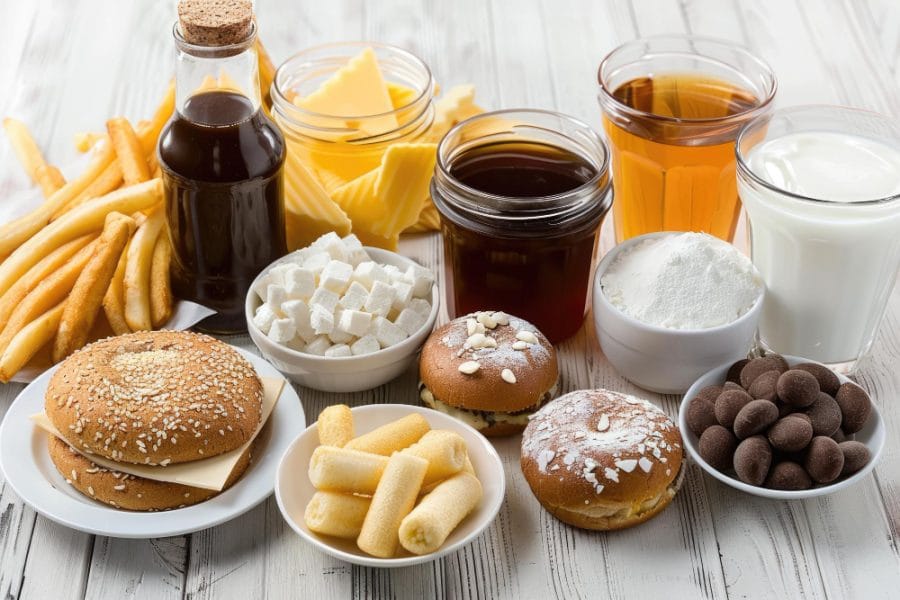Introduction
Our skin reflects what’s happening inside our bodies, and the foods we eat can have a powerful impact on our complexion. While genetics, lifestyle, and skincare routines play crucial roles in skin health, dietary choices can directly influence the appearance of our skin, sometimes for the worse. Foods that spike blood sugar, trigger inflammation, or disrupt hormone levels can make skin issues, particularly acne and breakouts, much harder to manage. For people who struggle with recurring blemishes or oily skin, identifying and avoiding the worst foods for skin health can be a game-changer.
When we consume foods high in sugar, unhealthy fats, and certain additives, our bodies can react in ways that clog pores, increase oil production, or inflame skin cells. As a result, these foods can disrupt the delicate balance needed for a clear, healthy complexion. In this post, we’ll explore ten common foods that could be contributing to acne and breakouts. By understanding how these foods impact skin, you’ll be better equipped to make choices that support a glowing, blemish-free face.
Affiliate Disclaimer
This blog post may include links to affiliate sites. If you click on an affiliate link and make a purchase, we may earn a small commission or receive other compensation at no extra cost to you. Please note that many of the links on our site are affiliate links. Our use of these links does not impact the products, services, or websites we recommend to you. This disclaimer covers all forms of communication with you, including our website, email, phone, social media, products, and other platforms.
Amazon Affiliate Disclaimer
We participate in the Amazon Services LLC Associates Program, an affiliate marketing program that allows us to earn fees by linking to Amazon.com and its affiliated sites. If you click on an Amazon affiliate link on our site and make a purchase, we may receive a small commission at no additional cost to you.
1. Refined Sugars
Refined sugars are one of the worst foods for skin health, as they lead to multiple processes that can trigger acne and breakouts. When we consume foods high in refined sugars, they cause a rapid spike in blood sugar levels, which then leads to a surge of insulin—a hormone that helps cells absorb glucose. While insulin is necessary for energy, too much of it can create a hormonal chain reaction that results in increased oil production. This excess oil mixes with dead skin cells and debris, clogging pores and providing an ideal environment for acne-causing bacteria to flourish.
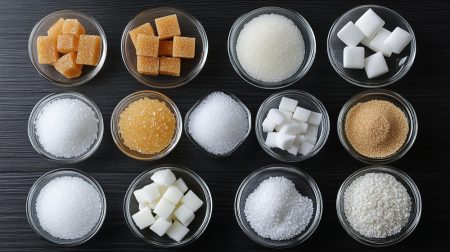
How Refined Sugars Impact Skin Health
High sugar levels in the bloodstream lead to a process called glycation, where sugar molecules attach to proteins, including collagen and elastin. These proteins are essential for skin elasticity and firmness, but glycation makes them stiff and more prone to damage. This process not only accelerates aging by making skin appear dull and less elastic but also increases inflammation throughout the body, which can exacerbate acne.
Examples of Common Refined Sugars
Refined sugars are often found in everyday treats and processed foods, making them hard to avoid. Foods like candy, sodas, pastries, breakfast cereals, and many snack bars are loaded with refined sugars. Even seemingly innocent foods like flavored yogurts and sauces can contain significant amounts of added sugar. For those looking to improve skin health, cutting down on refined sugars is a great first step toward clearer, healthier skin.
By avoiding refined sugars, you reduce inflammation and balance oil production, minimizing the risk of acne and breakouts. Eliminating one of the worst foods for the skin can make a noticeable difference in achieving a radiant complexion.
2. Dairy Products
Dairy products are often considered among the worst foods for skin, particularly for those who struggle with acne-prone skin. Dairy contains hormones and bioactive molecules that can interfere with the body’s hormonal balance, leading to increased oil production. This excess oil can clog pores, setting the stage for acne breakouts. Studies have shown that milk, especially skim milk, may be linked to higher acne rates due to its hormonal content and impact on insulin-like growth factor (IGF-1), a hormone associated with increased skin cell production and oil.
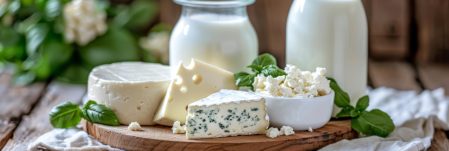
The Role of Hormones in Dairy
Milk from cows contains natural hormones, including androgens, which can be problematic for skin health. These androgens can stimulate oil glands, leading to the overproduction of sebum, a waxy substance that helps protect the skin but, in excess, can block pores and create an ideal environment for acne-causing bacteria. IGF-1, found in cow's milk, further compounds the problem by stimulating skin cell growth. When too many skin cells are produced, they can combine with excess oil and clog pores.
Common Dairy Culprits to Avoid
Dairy sneaks into many foods beyond just a glass of milk. Cheese, yogurt, ice cream, and milk-based sauces are all common sources. Even low-fat or skim varieties of dairy can still impact the skin due to their hormonal content. For anyone battling breakouts, reducing or eliminating dairy may lead to visible improvements in skin clarity.
Avoiding dairy can make a significant difference, especially for those sensitive to its hormonal effects. By cutting back on one of the worst foods for the skin, you reduce hormonal disruptions and give your skin a better chance to stay clear and balanced.
3. Fast Food and Fried Foods
Fast food and fried foods are often listed among the worst foods for the skin due to their high content of unhealthy fats, particularly trans fats and saturated fats, which can trigger skin inflammation and lead to acne. The heavy processing and frying involved in making these foods introduce free radicals, which can damage skin cells and worsen skin conditions. Consuming these types of fats and oils may not only affect heart health but also promote skin issues by increasing oil production and clogging pores.
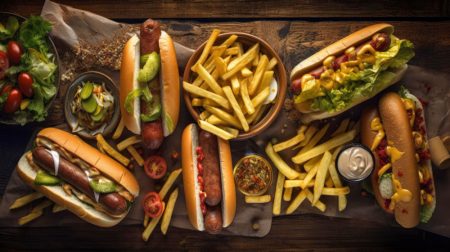
How Unhealthy Fats Affect Skin Health
The oils used in fast food and fried snacks are often reused multiple times, which alters their chemical structure and increases free radicals. These free radicals can damage skin cells, speed up aging, and create oxidative stress. This process disrupts the skin’s natural balance and leads to an inflammatorythe response in the body, contributing to acne and other skin conditions. The high sodium content in fast food also dehydrates the skin, making it look dull and increasing oil production as the skin tries to compensate for the lack of moisture.
Examples of Fast and Fried Foods to Avoid
Common fast foods and fried items like burgers, French fries, fried chicken, and chips are packed with trans fats and sodium. Even snacks like onion rings or fried pastries pose risks to skin health. Reducing fast food intake can make a noticeable difference in skin clarity, as avoiding one of the worst foods for the skin allows for reduced inflammation and a more balanced complexion.
Choosing healthier alternatives to fast food not only benefits your skin but also supports your overall health, helping you achieve a clearer, more radiant appearance.
4. White Bread and Pasta
White bread and pasta are considered some of the worst foods for the skin due to their high glycemic index (GI), which causes rapid spikes in blood sugar. Foods with a high GI lead to an increase in insulin levels, which can stimulate oil production and encourage the growth of acne-causing bacteria. Refined carbohydrates like white bread and pasta are quickly broken down into sugar in the body, fueling inflammation and setting the stage for breakouts.
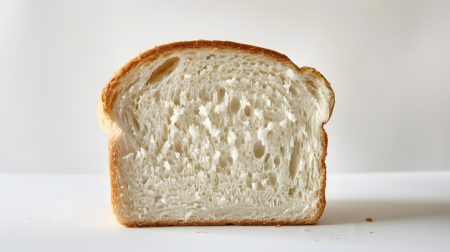
The Impact of High Glycemic Foods on Skin Health
High glycemic foods cause fluctuations in blood sugar that trigger a surge of insulin. This hormone increase prompts the skin to produce more sebum, an oily substance that, in excess, clogs pores and creates an ideal environment for acne development. Additionally, refined carbs can contribute to inflammation throughout the body, which shows up on the skin as redness, puffiness, and worsened acne. The repeated sugar spikes from these foods can further accelerate skin aging, making the skin appear dull and less elastic over time.
Refined Carbohydrates to Minimize for Clearer Skin
Common examples of high-glycemic, refined carbs include white bread, pasta, white rice, and sugary cereals. Opting for whole grains instead, such as brown rice, whole wheat, or oats, can help stabilize blood sugar levels and reduce acne risk. Eliminating refined carbs, one of the worst foods for the skin, can significantly improve skin clarity and reduce breakouts by balancing insulin levels and minimizing inflammation.
5. Chocolate (with High Sugar Content)
Chocolate, especially varieties high in sugar, ranks among the worst foods for the skin and is often blamed for aggravating acne and breakouts. While dark chocolate with low sugar may have some antioxidant benefits, sugary milk chocolate can cause more harm than good. High sugar content in chocolate leads to blood sugar spikes, increasing insulin levels, which in turn stimulates oil production and promotes acne. Additionally, sugary chocolate can drive inflammation throughout the body, which shows up on the skin in the form of redness, puffiness, and blemishes.
How Sugary Chocolate Affects Skin Health
The combination of sugar and dairy in most milk chocolate bars creates a perfect storm for skin issues. Sugar contributes to a process called glycation, where sugar molecules bond with collagen fibers, causing them to become stiff and less effective. This glycation process can lead to premature aging, making skin look dull and reducing its elasticity. Meanwhile, the dairy content in many chocolates adds another layer of risk by potentially disrupting hormonal balance, triggering an increase in oil production that clogs pores.
Types of Chocolate to Avoid for Clearer Skin
Milk chocolate, white chocolate, and chocolate candies with high sugar levels are most problematic for skin health. Switching to dark chocolate with 70% cacao or higher (and low sugar) may reduce skin issues. By avoiding sugary chocolate, one of the worst foods for the skin, you can reduce inflammation, support clearer skin, and even help prevent early signs of aging.
6. Processed Meats
Processed meats are among the worst foods for the skin due to their high sodium, preservative content, and often unhealthy fats, all of which can impact skin health. These meats, which include items like bacon, sausage, and deli meats, are usually loaded with salt and additives to enhance flavor and extend shelf life. However, the high sodium and preservative levels can lead to dehydration, which affects the skin by making it dry, irritated, and more prone to oiliness as the body tries to compensate for the moisture loss.
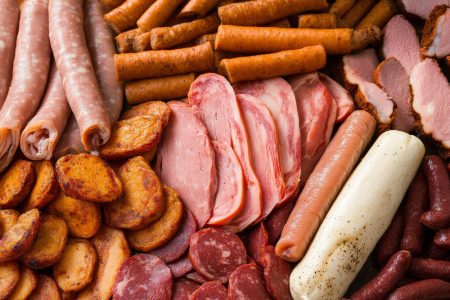
How Processed Meats Affect Skin Health
The high salt content in processed meats can dehydrate skin cells, drawing moisture out of the skin and leaving it dull, flaky, and prone to oil imbalances. When the skin is dry, it compensates by producing extra oil, which can clog pores and lead to acne. Additionally, processed meats often contain preservatives like nitrates and nitrites, which have been linked to inflammation in the body. This inflammation can exacerbate existing skin issues, including acne and redness, making breakouts harder to manage.
Examples of Processed Meats to Avoid
Common examples of processed meats include bacon, salami, ham, and hot dogs, as well as many types of deli meats. Reducing the intake of these meats can reduce inflammation and promote better skin hydration. By avoiding processed meats, one of the worst foods for the skin, you support a clearer, more balanced complexion, free from the dehydration and oil imbalances that contribute to breakouts.
7. Alcohol
Alcohol is widely regarded as one of the worst foods for the skin due to its dehydrating effects and potential to disrupt the skin’s natural balance. While alcohol itself isn’t a “food,” it acts on the body in ways that impact skin health significantly. When consumed, alcohol dehydrates the body, stripping moisture from the skin and leaving it more vulnerable to dryness, fine lines, and inflammation. As the skin becomes dry, it often compensates by producing excess oil, leading to clogged pores and a greater likelihood of acne and breakouts.

The Dehydrating and Inflammatory Effects of Alcohol
When alcohol is processed by the liver, it releases toxins that can trigger inflammation throughout the body, including the skin. This inflammatory response can worsen existing skin conditions like acne and rosacea, leaving skin red and swollen and making it more prone to breakouts. Alcohol also depletes vitamins and antioxidants, particularly Vitamin A, which is essential for cell renewal and healthy skin. Without sufficient vitamins, skin can appear dull and lose elasticity, making it more prone to blemishes and early aging.
Alcoholic Drinks to Minimize for Clearer Skin
Sugary cocktails, beer, and wine are some of the most problematic for skin health, as they combine dehydrating effects with high sugar content, exacerbating inflammation. By reducing alcohol consumption, you’re eliminating one of the worst foods for the skin, helping to maintain hydration, reduce inflammation, and improve skin tone. Drinking in moderation or choosing low-sugar options can make a noticeable difference in skin clarity and overall appearance.
8. Energy Drinks and Caffeine-Heavy Beverages
Energy drinks and other caffeine-heavy beverages are some of the worst foods for the skin due to their dehydrating effects and high sugar content. While caffeine itself can be enjoyed in moderation, excessive caffeine from energy drinks, sodas, and even some coffee drinks can overstimulate the body, leading to increased stress hormone levels that may trigger acne and skin inflammation. Additionally, energy drinks often contain significant amounts of sugar, which can spike blood sugar levels, stimulate oil production, and exacerbate breakouts.
The Impact of Caffeine and Sugar on Skin Health
High doses of caffeine can increase cortisol (the stress hormone), which can contribute to breakouts by encouraging oil production and inflammation in the skin. When stress hormones are elevated, the skin’s natural balance is disrupted, making it more vulnerable to acne and sensitivity. The high sugar levels in energy drinks further worsen the situation by causing insulin spikes that lead to excess sebum (oil) production, clogged pores, and an increased risk of acne. This combination of caffeine and sugar creates a perfect storm for skin issues, especially for those with acne-prone skin.
Caffeinated Beverages to Avoid for Clearer Skin
Common offenders include energy drinks, sodas, and sugary coffee beverages, as these combine high caffeine with high sugar. By reducing or avoiding these caffeine-heavy drinks, you can eliminate one of the worst foods for the skin, helping to keep stress hormones balanced and skin hydrated. Choosing low-sugar, moderate-caffeine options like herbal teas or water can significantly improve skin clarity and reduce the risk of breakouts.
9. Spicy Foods
Spicy foods are often overlooked as a contributor to skin issues, but for those with sensitive or acne-prone skin, they can be among the worst foods for the skin. When consumed in large amounts, spicy foods can dilate blood vessels and increase blood flow to the skin, which can lead to redness, flushing, and inflammation. For people who are prone to rosacea or acne, this heightened sensitivity can trigger or worsen breakouts, leaving skin irritated and inflamed.
How Spicy Foods Affect Skin Health
The capsaicin in spicy foods, which is responsible for the heat, can irritate the digestive system and induce an inflammatory response in the skin. This response is often visible as flushing or redness, especially in people with sensitive skin. Over time, repeated inflammation can damage the skin’s natural barrier, making it more susceptible to environmental stressors and prone to acne flare-ups. Additionally, spicy foods can increase perspiration, which, when combined with bacteria and oil on the skin, can clog pores and lead to breakouts.
Spicy Foods to Minimize for a Calmer Complexion
Common spicy items like hot sauce, chili peppers, and dishes with heavy seasoning should be enjoyed in moderation, especially if you notice skin irritation or redness after eating them. Avoiding excessive spicy foods, one of the worst foods for the skin can help maintain a calmer, more balanced complexion. Opting for milder seasonings allows sensitive or acne-prone skin to stay clear and irritation-free.
10. Processed Snacks (Chips and Crackers)
Processed snacks like chips, crackers, and other packaged treats are considered among the worst foods for the skin due to their high salt, unhealthy fats, and refined carbohydrate content. These snacks often contain excessive sodium, which can dehydrate the body and skin, leaving skin looking dull and increasing oil production as the skin tries to compensate for moisture loss. Moreover, the unhealthy fats and refined carbs in these snacks can lead to blood sugar spikes, triggering an increase in oil production and clogging pores, both of which contribute to acne and breakouts.
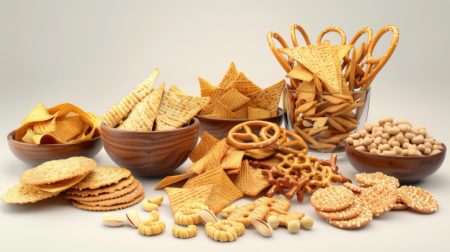
How Processed Snacks Impact Skin Health
Processed snacks are usually made with refined flours and oils that have been stripped of nutrients and transformed into simple carbohydrates. These simple carbs cause insulin levels to spike, which prompts an overproduction of sebum, the oily substance that can clog pores and lead to acne. The high sodium content in these snacks also dehydrates the skin, forcing it to produce more oil to counterbalance the dryness, which further increases the risk of breakouts. In addition, the unhealthy fats found in processed snacks can lead to inflammation, exacerbating redness and other skin issues.
Examples of Processed Snacks to Avoid for Clear Skin
Common offenders include potato chips, crackers, pretzels, and other salty, refined-carb snacks. Reducing the intake of these snacks can help control oil production, reduce inflammation, and improve skin hydration. By steering clear of processed snacks, one of the worst foods for the skin, you promote a clearer, healthier complexion and minimize the risk of acne and irritation.
Alternative Foods for Clear Skin
Choosing the right foods can significantly improve skin health and help counteract the effects of the worst foods for skin. A diet rich in whole, nutrient-dense foods supports skin from the inside out, providing hydration, antioxidants, and anti-inflammatory benefits. These foods work together to reduce oil production, prevent clogged pores, and help skin look radiant and clear.
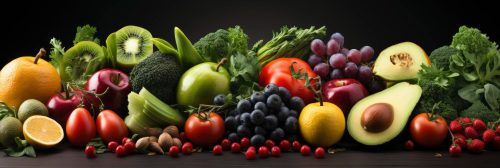
Fruits and Vegetables Rich in Antioxidants
Fresh fruits and vegetables, especially those high in vitamins A, C, and E, combat oxidative stress and reduce inflammation, both of which are essential for clear skin. Berries, leafy greens, bell peppers, and carrots are great choices that provide skin with the nutrients it needs to repair and stay resilient. Antioxidants help neutralize free radicals, preventing skin damage and premature aging.
Whole Grains Over Refined Carbs
Instead of refined carbs like white bread and pasta, which are some of the worst foods for the skin, choose whole grains such as oats, quinoa, and brown rice. These complex carbs provide steady energy without causing insulin spikes, reducing the risk of acne and excess oil production.
Healthy Fats for Skin Hydration
Healthy fats found in foods like avocados, nuts, seeds, and olive oil keep skin hydrated and reduce inflammation. Omega-3 fatty acids, in particular, are anti-inflammatory and can be found in fatty fish like salmon. Replacing processed fats with these beneficial sources can help maintain the skin’s moisture barrier and promote a smooth, healthy complexion.
Conclusion
In summary, what we eat can significantly influence our skin's health and appearance. Foods high in refined sugars, unhealthy fats, and excess salt can increase oil production, clog pores, and contribute to inflammation, making them some of the worst foods for the skin. By recognizing these dietary triggers and making simple swaps, you can promote a clearer, more balanced complexion. Incorporating nutrient-dense alternatives like antioxidant-rich fruits, whole grains, and healthy fats not only supports skin health but also enhances overall wellness. Remember, every small change matters; even reducing one or two of these skin-damaging foods can lead to noticeable improvements. So, take control of your diet, prioritize skin-friendly foods, and enjoy a radiant, acne-free glow that reflects your healthy lifestyle.


